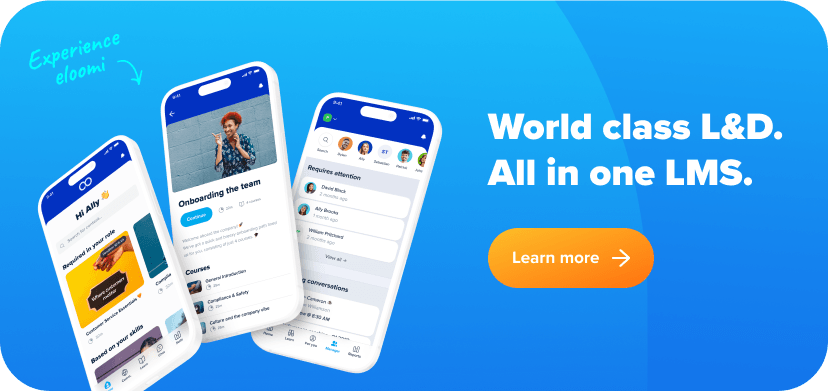With remote work and the rise of distributed teams, businesses are opting for digital solutions that can keep their workforce engaged and up-to-date with the latest training and development. One of the most effective tools for this is an elearning platform.
What is an elearning platform?
Let’s start by answering the first question that’s likely brought you here, ‘what is an elearning platform?’. To put it simply, an elearning platform is a digital solution designed to facilitate learning through online delivery. They host and manage training content, track learner progress, and provide interactive tools that support both formal and informal learning experiences.
While their primary role is to enable digital learning, elearning platforms today go beyond the basics to offer advanced features that not only consider, but actively seek to improve user experience, learning outcomes, and organizational efficiency. Learning management systems (LMS) are a common example of an elearning platform; designed to onboard and develop employees, LMS solutions like eloomi utilize the fundamental principles of elearning to deliver the most impactful learning experiences.
It’s been quite the journey…
Traditionally, these platforms were used for what we’d now see as more simple tasks like distributing training materials or tracking compliance-based learning. However, as technology and the understanding of learning have progressed, so too have these platforms.
Today, elearning platforms are adopting new technology such as AI content creation and algorithms to sort and recommend relevant training. By incorporating AI-driven learning paths, elearning platforms can adapt content delivery to the unique needs and learning styles of individuals. Features like adaptive learning further refine the process, adjusting difficulty levels or recommending resources based on the learner’s performance.
Another crucial change for the way we work today is device compatibility; mobile-first experiences are now essential for reaching employees in a mode that feels convenient and accessible. In fact, mobile devices have become the primary tool for accessing content, so platforms have optimized their interfaces to deliver seamless learning experiences on smartphones and tablets.
…But the basics are not forgotten
Modern elearning platforms haven’t got ahead of themselves though; despite these advancements, they continue to excel in their traditional roles – offering features that address key everyday training and development needs. At their core, these platforms pride themselves on expertly supporting employee training, compliance management and employee onboarding. All-in-one LMS solutions like eloomi are able to offer all of these from the very same platform; they’re the foundations of what an effective elearning platform should look like.

Understanding the learner’s journey
By offering tailored learning paths, we can create engaging experiences that, ideally, resonate with learners. Understanding the actual journey that users go through has become a critical aspect of elearning development. It’s an approach that aims to fully consider the learner’s path to their end-goal, enabling elearning providers to identify and create a solution that successfully facilitates this journey.
What are the three main types of elearning?
Everyone learns in different ways, and for elearning, there are three main types that are recognized:
- Synchronous – real-time, instructor-led sessions that foster immediate interaction and feedback.
- Asynchronous – learners engage with content at their own pace, offering greater flexibility.
- Blended – combines elements of both synchronous and asynchronous learning, creating a hybrid model.
Synchronous vs asynchronous learning
So why is this important? Modern elearning platforms have the capacity to cater to all of three learning styles. Synchronous learning is excellent for interactive sessions like webinars or live workshops, where learners can engage directly with instructors and peers via Q&As etc. On the other hand, asynchronous learning enables employees to complete training modules at their convenience, accommodating different schedules and time zones.
How elearning platforms break down barriers
It’s no exaggeration to say they have transformed workplace training by breaking down many of the barriers that previously limited access to learning opportunities.
Geographical barriers
One of the most significant advantages of elearning platforms is their ability to overcome geographical limitations, with traditional training programs often requiring learners to be physically present. This unsurprisingly limits participation to those who can commute to a particular location, meaning you’d be risking employees missing out on important training material. This also drives up the cost of traditional in-person learning whenever training sessions need to pull resources for all-day workshops with instructors. Elearning solutions eliminate the need for this, allowing learners from different locations to access the same content, helping to keep teams aligned.
Accessibility barriers
For many individuals, physical, sensory, or cognitive disabilities can hinder access to traditional forms of education. Fortunately, we’re now in a time where learning can be truly inclusive, and elearning platforms have played an important role in this.
Significant strides in overcoming accessibility barriers have been made following the implementation of features such as closed captions and transcripts for videos, screen reader compatibility (use of voice commands), and adjustable text sizes, contrast settings and keyboard navigation.
In addition to disability access, there is often support for multiple languages, making them adaptable for global audiences and thereby able to overcome linguistic barriers.
How do elearning platforms handle time zones and scheduling differences?
Scheduling conflicts and time zone differences often create challenges for both learners and instructors, especially in global organizations with employees spread across continents. Users are instead provided with flexible learning options, where they can both engage in asynchronous modules at their convenience or participate in live sessions that accommodate different time zones, often involving automated scheduling features to make sure content is accessible as and when required.
Building an elearning platform ecosystem
An elearning platform, like any modern digital solution, will need to integrate with a host of other business tools. When we say ‘elearning platform ecosystem’, we’re referring to a setup that allows for various integrations between other platforms systems, people and content to create a network that is aligned with the same organizational goals.For example, when an LMS is integrated with HR tools, it allows for new employees to be automatically enrolled in required training modules, such as compliance courses, job-specific skills, and company culture orientation, as soon as they join the organization. For customer-facing roles like sales, marketing, and customer support, integrating elearning with customer relationship management (CRM) systems delivers timely, contextual training.
Data and continuous learning
Data-driven decision-making is central to building an elearning ecosystem; in fact, elearning literally relies on data to function. Integrated platforms provide powerful analytics that offer deep insights into learner performance and training effectiveness, as well as an overview of business impact. eloomi is an LMS that uses AI to offer personalized learning paths based on user skills, job roles, and groups. These different paths include:
- Dynamic learning paths – Recommend new courses or modules based on an employee’s role or skills profile. This in turn creates a more tailored learning experience, helping to keep employees continually developing in ways that benefit both them and the organization.
- Continuous content updates – With our continuously updated content library, HR always have access to the most up-to-date courses, information, and skills training relevant to their industry.
How to choose the best elearning platform
Selecting the right solution is both a financially and operationally critical decision. It’ll require careful evaluation of available options based on how well the platform meets specific learning needs, as well as user experience, integration capabilities, and scalability.
Questions to consider when choosing
To begin the decision-making process, there are four key questions we’d recommend asking.
- Will the platform grow with your organization?
It’s important to choose a solution that can accommodate increasing user numbers and evolving learning needs. Even if there aren’t any plans for expansion in the near future, having the option now will save a lot of potential headaches further down the line.
- Can the platform integrate with your existing HR, CRM, and performance management systems?
We previously discussed the idea of elearning platform ecosystems. The solution in question will need to be able to integrate with your existing systems to limit unforeseen issues, particularly around the way data is shared and managed throughout your organization.
- Does the platform allow you to customize or import your own learning content?
Dynamic learning paths create better learning experiences;a major part of this is how the actual content itself is presented. Make sure the platform supports a variety of content types such as videos and quizzes that you can customize to tailor to your own specific learning needs.
- Is the platform intuitive for both learners and administrators?
It’s something that can easily be overlooked; but the solution needs to be easy to use for both learners themselves and the administrators. One without the other can be a quick road to mismanaged content, performance drop-offs and an elearning solution that can’t deliver your goals.
Importance of identifying industry, use case, and roles
Elearning platforms are developed for either a range of industries and roles or a more specific use case. This is often due to different industries and roles having unique training requirements. For example, healthcare organizations may need extensive compliance training, while tech companies focus on upskilling in software tools. Consider these points:
- Industry-specific needs: Establish whether the platform offers features tailored to your sector, such as compliance tracking for regulated industries.
- Role-based training: If required, be confident that the platform is flexible enough to support varied training needs for different roles, such as onboarding for new hires or advanced training for customer-facing teams.
eloomi: an all-in-one LMS
eloomi is an elearning platform that has been designed to address a wide variety of business needs as a scalable, all-in-one solution. Industries where eloomi thrives include retail, healthcare, hospitality, software, finance and manufacturing.
eloomi integrates with HR systems, performance management tools, and other software to create a smooth learning experience that can be managed without unnecessary complications. Whether you need compliance training, employee onboarding, or upskilling, eloomi offers a versatile platform that adapts to your organization’s unique needs with a reliable and always-accessible customer support service.
Empower elearning with eloomi
An elearning platform enables organizations to provide learning and training materials to their users and manage courses, compliance, onboarding and overall development. Choosing the best elearning platform for your business requires a careful evaluation of your own requirements.
Modern solutions, like the eloomi LMS, offer powerful features that go beyond traditional training by creating dynamic, personalized learning environments. With advanced tools like AI-driven learning paths, accessibility options, and seamless integrations, these platforms help businesses stay competitive while ensuring that employees are engaged, continuously developing, and fully compliant with necessary regulations.





